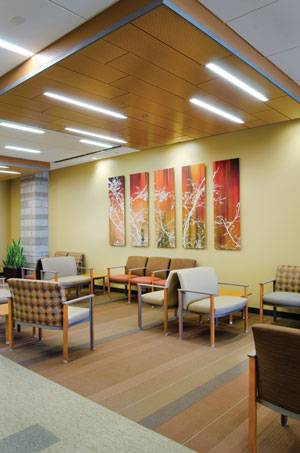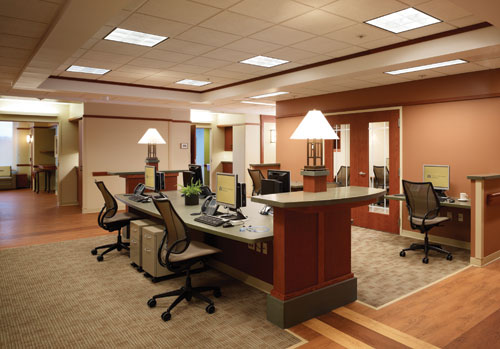Functional Color and Design in Healthcare Environments
An example of this is the design of the Banner Maricopa Clinic in Arizona. According to Sonja Bochart, associate, IIDA, LEED AP at SmithGroupJJR, “The design of Banner's Maricopa Health Center was based on the Banner Health Center prototype, which defines and reinforces a strong and relevant brand image of quality, patient-centered care.” The architect used a foundation color palette that represented the neutral, quiet background of the Center, combined with a stronger palette of accent colors. They used “the saturated greens of local flora, terracottas and plums that reflect the canyons and landforms of the Southwest, and smoky blues with hints of green to reflect the expansive desert sky—strategically aligned with specific areas of the Center. The overall effect is a timeless connection to nature and a sense of wellness.”
In some communities, hospitals are becoming both places for healing the sick as well as places for the community to gather for well-being. A “hospitality mentality” is becoming an all-important inspiration for healthcare designers. Computer desks, magazines, books, newspapers, movies on demand, 24/7 food service, whirlpools, spa services, valet parking, music and Internet accessibility are all part of the amenities common to the hotel industry that are now making hospital visits more comfortable and less intimidating. Hospital interior designers are also borrowing color palettes from the spa, hospitality and retail industries borrowing from branding initiatives that are intended to soothe or energize customers.
Ninety-five percent of all individuals who are asked how to alleviate a stressful situation respond that they are most comforted and soothed by being outdoors.3 Furthermore, they specifically mention that they would like to engage all of their senses. Physical and mental well-being is the top concern for a hospital. The exploration of the biologically based bond between humans and nature is especially important in environments where medical technology and products seem to be an antithesis to nature. To reduce stress and pain and to replenish the human condition, design professionals are learning to add strong references to nature in healthcare environments.
ACCESS TO NATURE
 |
Nature-themed artwork, warm colors, natural materials and ample lighting provide a soothing waiting area at the Banner Maricopa Health Clinic. Photo by Gregg Mastorakos: SmithGroupJJR |
Ninety-five percent of all individuals who are asked how to alleviate a stressful situation respond that they are most comforted and soothed by being outdoors.3 Furthermore, they specifically mention that they would like to engage all of their senses. Physical and mental well-being is the top concern for a hospital. The exploration of the biologically based bond between humans and nature is especially important in environments where medical technology and products seem to be an antithesis to nature. To reduce stress and pain and to replenish the human condition, design professionals are learning to add strong references to nature in healthcare environments.
It is becoming evident that direct access to nature through daylighting and landscaping are essential to our health. In the last decade, many healthcare projects are providing healing gardens and direct access to nature from the hospital setting. In addition, landscape design is now standard practice both for exterior gardens as well as interior gardens in healthcare facilities. Healing gardens offer a way to blur the lines between indoors and outdoors. Roof gardens are providing more ways to access nature as well as changing the views from many hospital rooms. A few years ago, the introduction of daylight deep into a large institutional facility seemed costly and frivolous. Today research has proven differently giving design teams the freedom to use daylight as a standard light source for interiors.
The human experience and need for nature has been discussed and developed by numerous writers and philosophers of the 20th century. Psychologist Erich Fromm coined the word “biophilia” to describe the profound human attraction to nature.4 Biophilia, a book written by entomologist Edward O. Wilson and co-authored by Steven R. Kellert in 1984, teaches the concept of this deep rooted connection to the natural world by humans and the relationship of this drive as an essential component of sustainable design.
Healthcare designer Barbara Huelat, FASID, AAHID, EDAC, has written extensively on designing with nature. She believes that exposure to natural materials and images have the benefit of reminding humans of their evolution and connections to nature. For designers like Huelat, environmentalism is a necessity, not a luxury. Biophilia has become a guideline for designing healthcare facilities that derive value from the natural world.
Another recent design movement “biomimicry” is based on the understanding of the basic principles of nature and imitating those principles to inspire design innovations. Nature teaches the design of systems and integration. The principles of biomimic design (organization, structure, diversity, color and movement) are being applied to healthcare environments.
COLORS OF A HEALING ENVIRONMENT The use of nature as a design principle is not new to healthcare design or to the principles of new movements such as biomimicry. Elmhurst Memorial Hospital was designed based on the Prairie School of Design. This style was chosen to harmonize with the hospital’s Midwestern, suburban Chicago location. The Prairie Style is characterized by long, horizontal lines that draw the eye to the surrounding landscape. In harmony with nature and drawing cues from the four seasons of the Midwestern year, the colors of the Prairie style are often inspired from an earthen palette. The range of colors can include fresh new green found in spring’s first growth to the deepening green leaves and grass of summer. Spring and summer also bring pops of color from flowering blooms including red, yellow, white, purple and blue. Ochre, amber, gold, fire red, oranges and deep burgundy come with the leaves and plants of fall. Browns and grays are revealed on the bare tree branches and trunks as winter arrives. Bringing these earth tones into the hospital interior provides a soothing, calming environment that promotes healing. At Elmhurst Memorial Hospital, the use of a nature-inspired color palette helped to enhance the sense of healing and well-being that the hospital wanted to promote. The hospital design was also influenced by the Planetree model of patient-centered care. The core components of design included these principles: • Human interaction Architect Anne Cox commented that the interiors at the Elmhurst Hospital were designed based on the client interest in bringing nature-inspired colors into the hospital setting to provide a calm and soothing atmosphere. |
 |
Influenced by both the Planetree model and the Prairie School, this caregiver work station at Elmhurst Hospital is designed for the comfort of staff, patient and family access. Photo by Scott McDonald |









